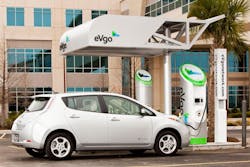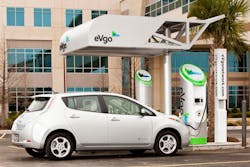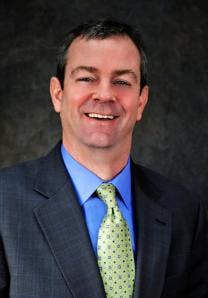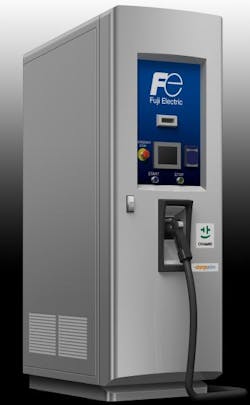As part of his speech, Obama introduced what was then called the “EV-Everywhere” program, the second in a series of Department of Energy (DOE) “Clean Energy Grand Challenges” aimed at trying to design and build electric vehicles (EVs) that more affordable and convenient to own and drive than gasoline-powered models by 2022 – just 9 years from now.
That effort is now getting a renewed push via a new program unveiled by the DOE at the Washington Auto Show this week, dubbed the “Workplace Charging Challenge,” which aims to increase number of U.S. employers offering EV recharging stations at their place of business by tenfold within 5 years.Now – while admittedly biased in this discussion – Brian Wynne (at left), president of the Electric Drive Transportation Association (EDTA) believes this “Workplace Charging” effort could be just what’s needed to help sales of EVs in the U.S. really take off.
“Automakers have seen exponential growth in electric drive sales over the last year,” he explained. “Yearly plug-in vehicle sales increased 198% in 2012, and the number of available models in the U.S. market is expected to triple by model year 2015. Since entering the market just over two years ago, over 70,000 plug-in vehicles have hit American roads. “
That’s why Wynne thinks strategically focusing on the expansion of charging infrastructure in the workplace would enable the motoring public alleviate a major cause of “range anxiety” simply because they could easily recharge their vehicles at work, where cars are already parked nearly half of the day.
In addition to the rapid expansion of home and workplace charging, he said, public recharging infrastructure is growing steadily, with over 5,000 stations operating in cities, suburbs and along highways – with a projected 1.5 million locations expected to be available by 2017, according to EDTA’s research.Wynne isn’t too far out on a limb here as telecommunications giant Verizon, along with 12 other companies – 3M, Chrysler, Duke Energy, Eli Lilly, Ford, General Electric, General Motors, Google, Nissan, San Diego Gas & Electric, Siemens and Tesla – are partnering with DOE to try and make “Workplace Charging” become a reality.
Indeed, OEMs are jumping on the “recharging network” bandwagon in a fairly big way, with Nissan Motors planning to help triple the current EV “quick-charging” infrastructure in the U.S. with the addition of at least 500 quick-charging stations in the next 18 months, including the greater Washington D.C. area's first fast-charge network.
"We envision a quick-charging network that links communities and neighborhoods where people live, work, shop and socialize," said Brendan Jones, Nissan's director of electric vehicle marketing and sales strategy. "Having a robust charging infrastructure helps build range confidence; boosting interest in EVs.”
He added that Nissan's strategy is focused on a three-prong approach to increase the number of available fast chargers – there are only 160 in the U.S. currently – though its dealer network, workplace campus charging and opportunities within local neighborhoods that help interconnect communities where drivers spend the bulk of their time and do the majority of their driving.
Jones also pointed out that Nissan is working with its dealers, local municipalities and infrastructure partners that include NRG Energy and its eVgo Network to increase the current number of public charging options.
"There are now about 1,500 private charging stations that exist in workplaces, allowing for what's called 'end-to-end' charging. That means that the car's battery is fully charged when the driver leaves home, and it will be fully charged when that person leaves work," said Nissan’s Jones. "It's another way to give electric vehicle drivers more flexibility to run errands and make other stops between work and home."
While sales of EVs have fallen short of projections to date, according to consulting firm Pike Research, interest in these vehicles is growing – particularly in large metropolitan areas.Cities like New York City, Los Angeles, San Francisco, and Seattle combine large population areas with early rollout schedules from vehicle manufacturers, and positive attitudes toward EVs among residents, making them fertile ground for EV manufacturers in the coming years, noted Dave Hurst (at left), Pike’s senior research analyst.
“More than a quarter of all annual U.S. EV sales will be in the top five metropolitan areas for current EV sales: New York, Los Angeles, San Francisco, Seattle, and Portland,” he said. “But thanks to a combination of positive attitudes towards green driving, high fuel prices, and state government support, California metropolitan statistical areas will account for more than one in five EVs sold.”
According to recent analysis by Pike, which is part of Navigant’s Energy Practice, sales of PEVs in the largest 102 cities in the U.S. will total slightly more than 1.8 million units from 2012 through 2020.
Pike added, though, that EV acceptance is strongly linked to not only the availability of EV models, but also the accessibility of charging infrastructure.
Texas, for example, has seen a dramatic increase in the number of EV charging stations available in 2012, according to Pike, with its index of positive opinions toward PEVs moved the state’s ranking from 42nd in 2010 tofourth in 2012, the largest change of any state in the index.
Will such investment in recharging infrastructure finally provide the long-awaited spark to drive greater sales and usage of EVs in this country? We might not have to wait long to find out.




